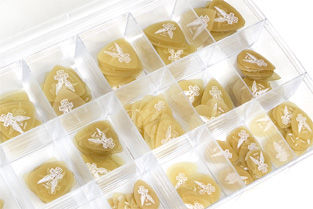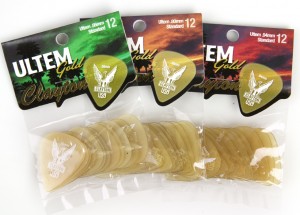Ultem – Amber Fields of Gold
A lot of people love my Utlem Gold pick, and I get asked often how I came across this material. So, I will tell this story as my first official blog post.
After the success of my Acetal pick, I decided to research additional plastics that would serve well for a new line of guitar picks. My goal was to locate the stiffest plastic I could find. So obtained several plastic samples. I cut each sample into a guitar pick. When I played the Ultem pick it really stood out amongst the others. It had an amazing clean, clear tone, didn’t wear, and was almost impossible to fracture.
Having a pick that produces clear overtones is essential to your music, it is what embellishes your playing. Plus, with such clean tones you get more longevity out of your strings. Which is an added bonus, that saves you some cash.
an added bonus, that saves you some cash.
I called this pick “Ultem” which is the actual name of the true plastic. I don’t dress it up or pretend it is anything else but what the plastic truly is. Also, I use it in its pure form. I don’t put deadening additives to cheapen it and destroy sound quality so I can get it out on the market for a “seemingly better price”.
It has been many many years since I introduced Ultem onto the guitar pick market, but since then my competition has come out with various versions of it. People swear up and down ours still sounds better. Unlike many of our competitors we don’t injection mold our picks (with the exception of Frost-Byte and S-Stone). Others use injection molding because it is cheaper to produce. You melt down the plastic and then mold it into the pick shape, which creates no wasted scrape material. My picks however are extruded. With extrusion the plastic is extruded out as a sheet with its grain intact. We then stamp the picks out with the grain going vertical down the pick. This grain helps to resonate  the sound down the surface mass of the pick. Similar to why the wood grain goes vertical down your guitar neck. This method creates a lot of excess plastic waste, but the maintenance of sound quality is essential for the player (the waste however is sold and recycled into other products). Keeping intact grain also make the pick more lively and snappy against the strings. Injection molding is very destructive to the plastic! It removes the grain and creates a random matrix pattern, thus preventing the telescoping of the sound.
the sound down the surface mass of the pick. Similar to why the wood grain goes vertical down your guitar neck. This method creates a lot of excess plastic waste, but the maintenance of sound quality is essential for the player (the waste however is sold and recycled into other products). Keeping intact grain also make the pick more lively and snappy against the strings. Injection molding is very destructive to the plastic! It removes the grain and creates a random matrix pattern, thus preventing the telescoping of the sound.
Do you want to know a easy way to tell if your pick resonates sound well? Take an Ultem pick and different material such as Nylon. Drop each of them onto a glass surface. You will immideatly hear the difference. Ultem will have a bright loud ping, while nylon has a quiet thud sound. This simple experiment tells you that the sound isn’t resignating from the Nylon pick. I always encourage a guitarist to do this on the glass store counter-top to hear if the plastic is dead or alive. Try it, you will hear the difference, and so will the listeners of your music.












